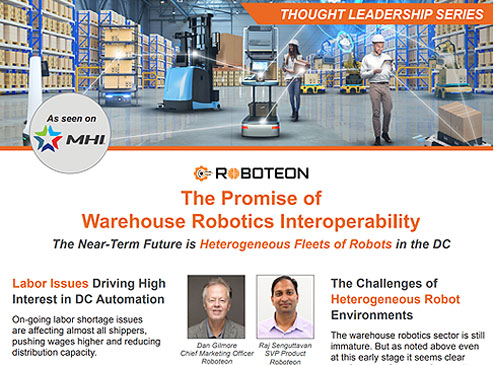Roboteon in Interview with Kevin Lawton of the Popular the New Warehouse Podcast

At the giant MODEX show held in Atlanta in mid-March, Roboteon chief marketing officer Dan Gilmore did a live stream interview with Kevin Lawton, founder of the popular New Warehouse blog series.
That interview is transcribed below, and covers a number of interesting topics around warehouse automation and warehouse robotics:
Lawton: Tell us a Little about Roboteon and what that is.
Gilmore: Roboteon provides a software platform for robotics automation in distribution and manufacturing.
This is actually kind of our coming out party here at MODEX – the company was founded about a year and a half ago. We spent that time building a very powerful product platform as well as getting the organization together.
So now we are here at MODEX taking the product to market.
Lawton: How about a little bit more on what Roboteon does. It sounds like you are working the integration side between solutions, right?
Gilmore: That’s just a part of it really. We have what we call the Robotics Fulfillment Platform, which enables robotic-oriented workflows in distribution and manufacturing.
We also provide interoperability between different robotic systems. Just for example, at our booth here at MODEX, we’re demonstrating three different Autonomous Mobile Robots or AMRs and two different pick arms – one for piece picking and one for case picking – all operating in one environment.
We’ve looked around and don’t see anyone else doing it on the show floor here, so we think we have something kind of special.
Lawton: Yes absolutely. I think that interoperability is such an important key as well. This show is now so massive, with different types of automation solutions, robotics solutions, software solutions – at some point, I think it’s inevitable that you are going to have solutions from different vendors, so how do you get those things to work together?
So tell us a little bit about how you are working with these different solution providers so that you can support them and the end users too?
Gilmore: You are right, we are going to see heterogeneous environments on the floor, there’s no question about that.
So we’ve been talking to attendees here on the show floor. Some get it and are planning their technology moves accordingly, bur for others it’s more of a wake-up call – “I hadn’t thought about that” -meaning what do I do after I put in some first type of automation and then another after that.
So part of it is just the connectivity or integration itself to the equipment – for many companies this turns out to be surprisingly hard – but we’ve taken a lot of the mystery out of that. When we start working with a new hardware partner we typically get the integration done in one to two days.
Lawton: Oh wow.
Gilmore: We do that in part through the use of AI to help with the data mapping, especially with integrating a WMS to our platform and then to connect the robotics on the other side.
So you have to first connect the one thing, whether it’s a robot, goods-to-person system, whatever – but then you’ve got to manage the workflow across processes or other systems, not only initially but over time.
And that’s a whole different matter – most companies aren’t thinking that way yet, because they just started at one place, or maybe just are doing a pilot program, but you have to think about the long term in terms of how do I manage this across different equipment types or sub-processes.
That means how do I quickly and effectively manage changes in those processes or robot vendors over time.
If someone comes out with a new robot that’s cheaper, faster, better, that’s coming from China or wherever – if you bought in fully to the robotic vendor’s software then how do you add that new vendor’s hardware seamlessly into the operation? You can’t. You have to operate dual systems or throw away what you already have.
With the way Roboteon does it, you can keep what you’ve got, add in the new robot, and they all work together under one platform.
We have a saying about “robots, people and automation working together as one,” and that’s really what the goal is, equipment from two or even multiple vendors operating as one system.
Lawton: I think that is the key thing, everything working as one system, as you said, and it’s great you guys are on a mission to make that happen
I know from my experience as a warehouse manager and working with multiple systems and trying to deal with the data that’s coming out of one system and the data coming out of that system, or maybe the data isn’t flowing right from one system to another and that’s why we’re having issues – it’s just a headache that you don’t want to deal with.
The way you are bringing it altogether and orchestrating it in that way is a key factor.
You mentioned this is kind of your coming out party here at MODEX – what has been the reaction from attendees to the solution and message?
Gilmore: You could almost sort of segment that.
There is a small group that already understands the problem and came by looking for what we do.
Others are starting their warehouse automation journey but haven’t really thought it all the way through. They may be pursuing proof-of-concepts or similar tests, but may not have considered the big picture not only for an initial deployment but how to add on new technologies over time.
But as we spoken with some of this group, you can see a sort of light bulb go off, and the realize “I need to start thinking about this,” because really many people really focus on the hardware, they are not thinking enough about the software, or just assume they will just get it from the robot provider.
You often can, but sometimes you can’t, and we talked about some of the limitations to that approach.
Another interesting thing is that I also spoke with some attendees that have what I will call a global problem. These are large companies that where every country or region of the world has the ability to source warehouse equipment on its own.
Let’s use a consumer packaged goods type of example, where the process might call for use of a layer picker robot.
It might work in conjunction with other types of automation, such as mobile robots. But in this process, the vendor that Germany wants to use is different from the one the UK or the US wants to use.
So what these companies want is a software platform that allows the process to be defined and the automation communicating with each other, but you just plug in the specific layer picker or point-to-point AGV or whatever in your local geography.
We also talked to a guy from a prominent high tech company that has eight or nine different mobile robots, each with point-to-point integrations to the ERP, and they are adding more. This added to costs and limits flexibility. He was like “It has to end.”
Lawton: That’s really interesting. It sounds like you can deploy your solution in 10 different ways but standardize the process, if you will - that makes a lot of sense.
Gilmore: As I said, it’s all about flexibility. Automation technology is moving so fast. You don’t want to lock yourself in. You want to have maximum flexibility because no one can predict what’s going to happen five years from now.
Flexibility has a cost. You usually have to invest something to get it. But I think in the long-term, rather than finding a few years from now that you are at a dead end and have to build stuff from scratch again.
With the right robotics platform that provides that type of agility over time it is going to pay itself off in spades.
Lawton: Interesting. With your launch here, it looks like you have a great platform, and it’s a great thing.
I think at the end of the day, it just makes it easier for the operators to deal with all these solutions and getting the right solution without worrying about data challenges on the back end.
Gilmore: Can I make a quick comment on that? We bring a lot of domain expertise, with a number of us coming out of the Warehouse Management world. So the interface between the WMS and the automation layer or more specifically our software platform, there are a lot of nuances on that, depending what WMS it is and how it was deployed.
But one of the things we’ve built is a portfolio of execution applications: piece picking, case picking, cluster picking, zone picking, replenishment etc., all robot-infused, if you will. So these aren’t the same applications you might get from your WMS. They’ve been designed for different ways of using of robotics for piece picking, case picking, and other work flows.
Some of the companies that are out there that are doing something like what we’re doing are focused on the connectivity part. We view that as sort of table stakes – it just has to be done. But for many it still too hard, takes to long, it’s too expensive.
Time-to-value is also an issue.
So we look at the robotic integration as the starting point, but we’re delivering more of an end-to-end solution, and that includes those execution applications I just referenced.
Lawton: It’s great that you have those execution applications. You’re trying to a make the warehouse worker’s life easier, the warehouse manager’s life easier, less to worry about.
Gilmore: Just one more point on that: all of those applications have the same user interface, the same look and feel. That gives you the ability to move workers around as needed, because as they go to a new area, and it looks the exactly like the applications they are used to, so they can get up to speed much quicker.
Lawton: It’s very interesting what you are doing what there at Roboteon. I appreciate your coming by and talking with us.
Gilmore: Kevin, great conversation as always. Look forward to doing it again soon.
FEATURED BLOG

Roboteon Quoted in an Article on Warehouse Automation by Modern Materials Handling
READ MORENEWS
Roboteon and Stellium announce Strategic Partner Partnership for Robotics and Automation Solutions for SAP EWM using Roboteon’s Multi-Agent Orchestration Platform
LEARN MOREMeet Roboteon at SAP Sapphire in Orlando
LEARN MOREWell-Known Former Gartner Analyst Dwight Klappich Joins Roboteon as Strategic Advisor
LEARN MOREResources

Thought Leadership Series: The Promise of Warehouse Robotics Interoperability
DOWNLOAD REPORT
Understanding Warehouse Robotics Software - White Paper
DOWNLOAD REPORT
Roboteon Solution Overview
Watch Video